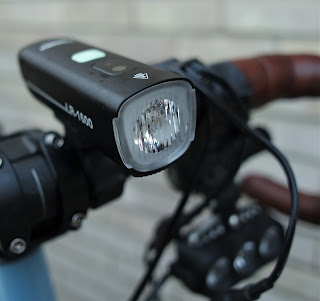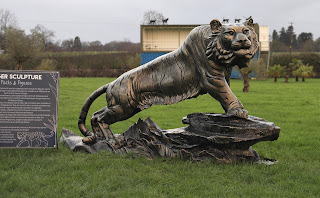Snow and ice relented, I switched to the fixed gear winter trainer to get some proper miles on the CST pairing and kept Ursula’s spikes handy, since the reprieve was thought to be short-lived. The CST tyres are proving compliant and engaging along the wintry lanes- much as I’d hoped and expected to be honest.
I’ve deliberately gone the mix n’ match route to ensure I can evaluate performance in precisely the same conditions. Both hold their line very reliably around slimy corners and at 70 odd psi, there’s little hum from the Pika’s knobblies. Thus far at least, their respective tread patterns aren’t attracting much muck- the sort that thorns and other sharps get lodged in.
I wasn’t expecting trouble with the K-lite Bike packer Ultra K LITE BIKEPACKER ULTRA DYNAMO LIGHT | cycling-not-racing (sevendaycyclist.com) dynamo headlamp, but it began flickering and delivering little more than a glimmer.
Thankfully, I had the Ravemen LR 1600 Ravemen LR1600 Front Light | cycling-not-racing (sevendaycyclist.com) as backup, so switched to that during the ride and replaced the K-Lite Bike Packer Ultra for the K-Lite Ultra LD (Low Drag) counterpart. K-LITE ULTRA LOW DRAG DYNAMO LIGHT | cycling-not-racing (sevendaycyclist.com) This delivers 750lumens, which is lower than the1300 generated by its sibling but in my experience, the lower drag factor means you can ride faster and get full output, most of the time.
Then, of course, the diodes are designed for road riding and there’s less impact upon navigational clout. I’m certainly not struggling to navigate pitch-black lanes at a decent lick. This also serves to illustrate why secondary and/or backup lighting is important, especially on longer rides.
I had been tempted by On-One's Mulo frame On-One Mulo Frame | Planet X but aside from clearance for 40mm tyres at the rear triangle, there’s too little separating it from my fixed gear winter trainer, so no indulgences. I had heard a rumour that there was a titanium prototype of the Ilpompino frameset. I’d never heard of, let alone seen one.
Lightweight, phenomenally corrosion resistant (wouldn’t need paint)- arguably my ideal basis for a winter/trainer. When it comes to framesets with a definite road heritage, Kona Paddy Wagon is another firm favourite of mine. Clearance for 700x28c with full-length mudguards (eyelets), two sets of bottle bosses.
I reviewed it back in 2006 Kona Paddy Wagon 06 - BikeRadar but had too much going on financially to justify indulging. Obviously, I would’ve gone the hub dynamo and high-power lamp, SQR Tour route- all stuff of the classic British training bike. Would’ve doubtless upgraded the fork for something carbon with eyelets and by now, the OEM paintwork would’ve gone, replaced with a chrome effect powder-coated base and Rosso red topcoat leaving the rear triangle “half-chromed”.
The Carbon Tech carbon fork was cut and prepped ready for transplanting, literally the afternoon it arrived but I stopped short of installing, given I was weary and didn’t want to get “committed” at that stage.
I also (surprise, surprise) found a TRP HYRD caliper for the right price and thought it best to install the pair together and relubricate the lower race with some Juice Lubes Bearing Juice which all told, wasn’t conducive to rushing.
I pruned the steerer tube, added Zefal Skin Armor to the blades, protecting them from cable rub and similar damage ZEFAL SKIN ARMOR ROLL | cycling-not-racing (sevendaycyclist.com), instated the Star Fangled Nut and quit while ahead.
There’s often a fine line between the euphoria of accomplishment, which hides the inner fatigue and is superseded by a lingering frustration of being behind. In terms of weight, these tip the scales at 742g, its almost 100g heavier than the Kinesis KINESIS DC37 DISC FORK | cycling-not-racing (sevendaycyclist.com) but I’d rather a bit of overbuild at this end of the market.
The fixed’s VDO computer’s head mount battery was nagging me about its impending demise, so I switched that and checked some small fasteners while I was there.
Talking of building stuff, I loaded up the KA and headed to the Welsh borders with Sharon for a festive break. We’d been wanting to see the British Ironwork Centre & Sculpture Park in Oswestry for several years and managed to catch it, before Christmas closing. We arrived with a couple of hours grace and while light was still favourable. I took these with 30mm 1.8 prime and 16mm f2.4 prime lenses bolted to Samsung NX1000 and 3000 bodies.


























